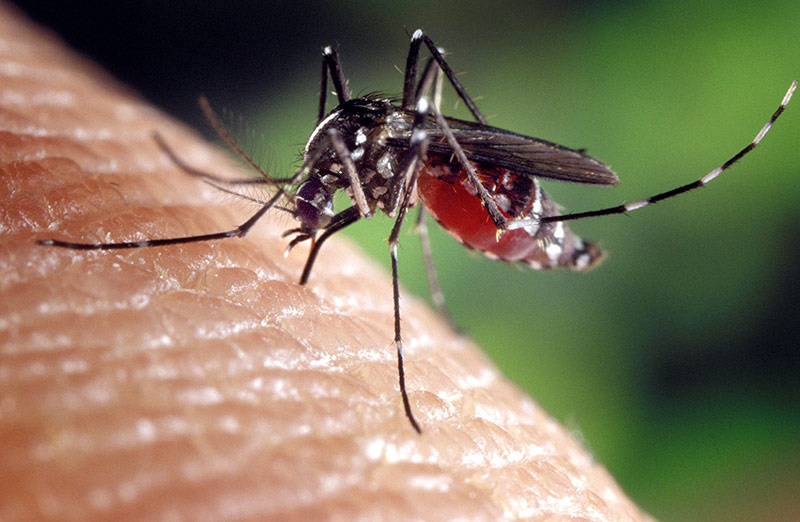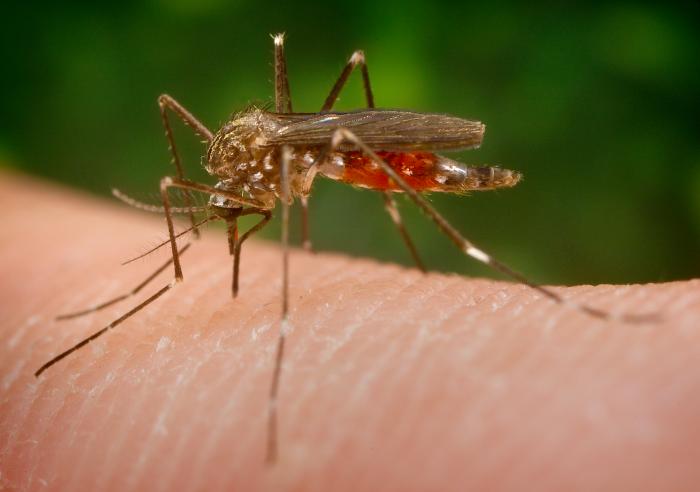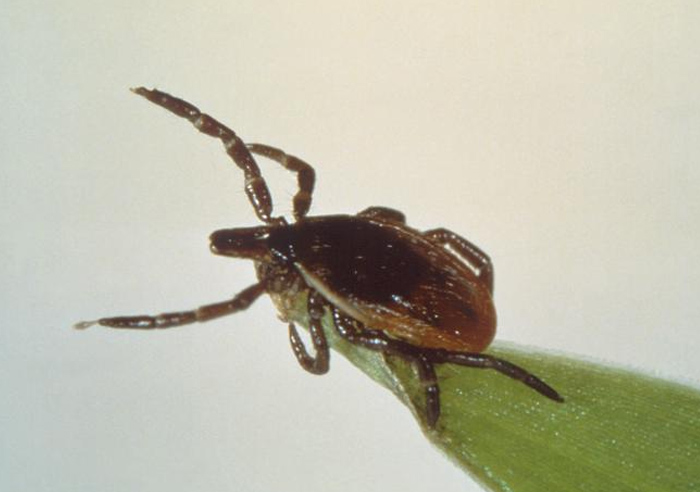Mosquitoes and Ticks
West Nile Virus
Van Wert County General Health District environmental health staff conduct surveillance activities to detect the presence of West Nile Virus activity in the county, as well as educational outreach to inform the public on how to protect themselves from this potentially dangerous virus.

What You Can Do To Prevent West Nile Virus
Mosquitoes lay their eggs in standing water, which includes puddles, stagnant ditches, and containers such as old tires, buckets, cans, neglected swimming pools, etc. Storm sewers, culverts, and catch-basins, etc. provide an outdoor resting place for adult Culex pipiens mosquito (the common house mosquito) which is most commonly associated with West Nile virus. This mosquito often enters homes through unscreened windows or doors, or broken screens.
- Make sure that doors and windows have tight-fitting screens. Repair or replace all torn screens in your home.
- Remove all discarded tires from your property.
- Dispose of tin cans, plastic containers, ceramic pots, or similar water-holding containers.
- Make sure roof gutters drain properly. Clean clogged gutters in the spring and fall.
- Clean and chlorinate swimming pools, outdoor saunas and hot tubs. If not in use, keep empty and covered.
- Drain water from pool covers.
- Change the water in bird baths at least once a week.
- Turn over plastic wading pools, and wheelbarrows, etc. when not in use.
- Clean ditches of obstructions so they drain properly.
- Eliminate any standing water that collects on your property.
- Check trees for cavities that hold water and fill them with soil, gravel, or sand.
- Remind or help neighbors to eliminate breeding sites on their properties.
Mosquito Control with Pesticides
Larvicides can be used to control mosquitoes in the aquatic stage before they become biting adults. This type of control generally has the least effect on non-target species and the environment.
- Microbial larvicides such as Bacillus thuringiensis var. israelensis and Bacillus sphaericus can be used successfully in a broad range of freshwater habitats. Blood samples can be taken from wild birds to see if they are infected with West Nile and other viruses.
- Biochemical larvicides (insect growth regulators – IGRs) such as methoprene can also be used in a variety of habitats.
- Mono-molecular surface film larvicides can be used in polluted or artificial habitats, but should not be used where non-target insects are important resources.
Mosquito adulticides should be considered the least desirable method of control and only used when isolations of virus and/or evidence of disease has been established. These materials have strengths and drawbacks that will influence which material is most appropriate for a given situation, and all must be applied according to label directions. Currently available adulticides include organophosphates, pyrethrins, and pyrethroid-based insecticides. These may be applied by hand-held, or backpack, foggers, or fixed-wing or rotary-wing aircraft.
Application of adulticides by truck-mounted foggers, fixed-wing or rotary-wing aircraft is usually done by government agencies or private contractors. Those who apply pesticides in these ways must be licensed, have their equipment properly calibrated, and adhere to the label directions.

Repellents
If you will be outside during evening, nighttime and dawn hours, consider the use of an insect repellant containing 10% or less DEET (N, N-diethyl-methyl-meta-toluamide) for children and no more than 30% DEET for adults. DEET is effective for approximately four hours. Avoid prolonged or excessive use of DEET and use it sparingly to cover exposed skin and clothing. Do not use DEET on infants or pregnant women and do not apply DEET directly to children. Apply it to your own hands and then put it on the child. Always use DEET according to the manufacturer’s instructions.
More information is available on CDC’s website page: Updated information regarding insect repellents.
Remember that Vitamin B, ultrasonic devices, incense and bug zappers have not been shown to be effective in preventing mosquito bites.
Information from: Ohio Department of Health: Zoonotic Diseases

More Information

Transmission Cycle
West Nile Virus is spread to humans by the bite of an infected mosquito. When a mosquito bites a bird that carries the virus, the mosquito becomes infected. It is believed that people cannot get West Nile Virus directly from another person, or animal, that has the disease. It is believed that this disease is only transmitted by mosquitoes.
Being bitten by an infected mosquito will not necessarily make you sick, since most people who are infected with West Nile Virus either have no symptoms or experience mild illness. If illness were to occur, it would occur within 5 to 15 days of being bitten by an infected mosquito.
Symptoms in Humans
Mild infections are common and include fever, headache, and body aches, often with skin rash and swollen lymph glands. Headache, high fever, neck stiffness, stupor, disorientation, coma, tremors, convulsions, and paralysis mark more severe infection. In some individuals, especially the elderly, West Nile virus can cause serious disease that affects brain tissue. At its most serious, it can cause permanent brain damage and can be fatal.
Diagnosis
Your physician will first take a medical history to assess your symptoms. People who live in or traveled to areas where West Nile virus activity has been identified are at risk of getting West Nile encephalitis. It is important to tell your doctor your recent travel history (the last 2 months). Persons older than 50 years of age have the highest risk of severe disease. If you are determined to be at high risk and have symptoms of West Nile encephalitis, your provider should draw two blood samples about two to three weeks apart and send them to a commercial or public health laboratory for confirmation.
Treatment
There is no specific therapy. In more severe cases, intensive supportive therapy is indicated, often involving hospitalization, intravenous fluids, airway management, respiratory support (ventilator), prevention of secondary infections (pneumonia, urinary tract, etc.), and good nursing care.
West Nile Surveillance
People often ask, “Why do you test for this disease in animals when you know it is there?” The answer lies in the definition of the word “surveillance”. Yes, we know it is there. But how much? Is it in epidemic proportions in wild animals? The term for that is epizootic. If the number of infected animals or mosquitoes, for example, is increasing, then we may be facing a spillover into the human population. Thus, knowing what is going on in animals and mosquitoes gives us a “heads-up” that people are at greater risk of becoming ill with these infections. This is most important regarding those diseases for which there is no vaccine or effective treatment for humans. Mosquito-borne viruses, such as West Nile virus, fall into this category. That’s why we monitor these diseases in animals and arthropods such as mosquitoes. It gives a forewarning. People can then be advised to protect themselves, and mosquito and other vector control agencies can increase their activities to protect the public from illness and death.

Mosquitoes
Adult mosquitoes may be trapped from April to October throughout Ohio, concentrating on human population centers. The number of sites, the frequency of trap placement, and number of traps per site will vary depending on where the virus is most likely to be present.

Ticks
The Van Wert County General Health District can send in live or dead ticks to be identified at the Ohio Department of Health. Live ticks that may be the vector of Lyme disease can be tested for that disease. If you wish to have a tick tested please keep it alive if possible and put it in a container with a moistened cotton ball. Bring the tick to the Health District.

Birds
Birds are the natural reservoir for West Nile virus. If a mosquito bites an infected bird and the virus is transmitted to the mosquito, it may then become a host itself. If the same mosquito then bites a human, it can pass the disease to the human. Because of this cycle, noticing dead birds could be the first sign of West Nile Virus in an area.
Horses
Horses are known as a dead-end host of West Nile virus, that is, they can become ill with West Nile virus, but they do not maintain sufficient virus in the blood to infect either other mammals (including humans) or mosquitoes. Surveillance of horses has occurred in areas with a history of West Nile virus and in additional States on the eastern coast of the United States to monitor the possible spread of WNV. This surveillance consists of investigating suspect cases in horses. Because horses are not known to play a role in transmission of WNV, quarantines were never placed on any non-clinically ill horses in the outbreak area. However, some foreign countries have banned the importation of horses from New York.
Symptoms in Horses
Clinical signs of West Nile virus infection in horses include: listlessness, stumbling, lack of coordination, ataxia, partial paralysis, and death. Horses with West Nile virus often do not have a fever. See The Ohio State University Veterinary web site for more details.

